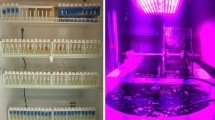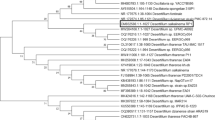Abstract
Nutrient removal from artificial wastewater in autotrophic condition by the co-culture consortium of Scenedesmus dimorphus and nitrifiers was investigated. The batch experiments of co-culture, S. dimorphus- and nitrifiers-only treatments were conducted and compared for 9 days. As a result, the co-culture system showed enhancement in both nitrogen (N) and phosphorous (P) removal compared to each single culture. Especially, total N removal efficiency and P removal efficiency in co-culture reactor were enhanced 3.4 and 6.5 times compared to nitrifiers-only reactor, respectively. This result implies that post-treatment systems such as denitrification of nitrate and luxury uptake of P can be deducted by using the co-culture consortium of Scenedesmus dimorphus and nitrifiers. In addition, unlike nitrifiers-only reactor, the co-culture maintained high Dissolved Oxygen (DO) without external aeration. Thus it is suggested that co-culture of Scenedesmus dimorphus and nitrifiers is an efficient and economic method to removal nutrient from wastewater.
Similar content being viewed by others
References
APHA-AWA-WEF (2005). Standard methods for the examination of water and wastewater, 21st ed, Washington: American Public Health Association.
Boelee, N. C., Temmink, H., Janssen, M., Buisman, C. J. N., and Wijffels, R. H. (2011). “Nitrogen and phosphorus removal from municipal wastewater effluent using microalgal biofilms.” Water Research, Vol. 45, No. 18, pp. 5925–5933, DOI: 10.1016/j.watres.2011.08.044.
Cai, T., Park, S. Y., and Li, Y. (2013). “Nutrient recovery from wastewater streams by microalgae: Status and prospects.” Renewable and Sustainable Energy Reviews, Vol. 19, pp. 360–369, DOI: 10.1016/j.rser.2012.11.030.
Chevalier, P. and De la Noue, J. (1985). “Efficiency of immobilized hyperconcentrated algae for ammonium and orthophosphate removal from wastewaters.” Biotechnololy Letters, Vol. 7, No. 6, pp. 395–400, DOI: 10.1007/BF01166210.
Collos, Y., Vaquer, A., and Souchu, P. (2005). “Acclimation of nitrate uptake by phytoplankton to high substrate levels.” Journal of Phycology, Vol. 41, pp. 466–478, DOI: 10.1111/j.1529-8817.2005.00067.x.
de-Bashan, L. E., Hernandez, J-P., Morey, T., and Bashan, Y. (2004). “Microalgae growth-promoting bacteria as “helpers” for microalgae: A novel approach for removing ammonium and phosphorus from municipal wastewater.” Water Research, Vol. 38, No. 2, pp. 466–474, DOI: 10.1016/j.watres.2003.09.022.
de-Bashan, L. E. and Bashan, Y. (2010). “Immobilized microalgae for removing pollutants: Review of practical aspects.” Bioresource Technology, Vol. 101, No. 2, pp. 1611–1627, DOI: 10.1016/j.biortech.2009.09.043.
Ebeling, J. M., Michael, B., Timmons, M. B., and Bisogni, J. J. (2006). “Engineering analysis of the stoichiometry of photoautotrophic, autotrophic, and heterotrophic removal of ammonia–nitrogen in aquaculture systems.” Aquaculture, Vol. 257, Nos. 1–4, pp. 346–358, DOI: 10.1016/j.aquaculture.2006.03.019.
González, C., Marciniak, J., Villaverde, S., León, C., García, P. A., and Muñoz, R. (2008). “Efficient nutrient removal from swine manure in a tubular biofilm photobioreactor using algae–bacteria consortia.” Water Science and Technology, Vol. 58, No. 1, pp. 95–102, DOI: 10.2166/wst.2008.655.
Guieysse, B., Borde, X., Munoz, R., Hatti-Kaul, R., and Nugier-Chauvin, C. (2002). “Influence of the initial composition of algal bacterial microcosms on the degradation of salicylate in fed batch culture.” Biotechnology Letter, Vol. 24, No. 7, pp. 531–538, DOI: 10.1023/A:1014847616212.
Han, T. H., Zhang, S., Cho, M. H., and Hwang, S.-J. (2017). “Enhancement of volatile fatty acids removal by a co-culture of microalgae and activated sludge.” KSCE Journal of Civil Engineering, KSCE (In press), DOI: 10.1007/s12205-016-1271-1.
Hende, S. V. D, Vervaeren, H., and Boon, N. (2012). “Flue gas compounds and microalgae: (Bio-) chemical interactions leading to biotechnological opportunities.” Biotechnology Advances, Vol. 30, No. 6, pp. 1405–1424, DOI: 10.1016/j.biotechadv.2012.02.015.
Hu, X., Xie, L., Shim, H., Zhang, S., and Yang, D. (2014). “Biological Nutrient Removal in a Full Scale Anoxic/Anaerobic/Aerobic/Preanoxic-MBR Plant for Low C/N Ratio Municipal Wastewater Treatment.” Chinese Journal of Chemical Engineering, Vol. 22, No. 4, pp. 447–454, DOI: 10.1016/S1004-9541(14)60064-1.
Hwang, S.-J., Havens, K. E., and Steinman, A. D. (1998). “Phosphorus kinetics of planktonic and benthic assemblages in a shallow subtropical lake.” Freshwater Biology, Vol. 40, No. 4, pp. 729–745, DOI: 10.1046/j.1365-2427.1998.d01-660.x.
Kang, Z., Kim, B. H., Ramanan, R., Choi, J. E., Yang, J. W., Oh, H. M., and Hee-Sik Kim (2014). “A cost analysis of microalgal biomass and biodiesel production in open raceways treating municipal wastewater and under optimum light wavelength.” Journal of Microbiology Biotechnology.
Karya, N. G. A. I., van der Steen, N. P., and Lens, P. N. L. (2013). “Photo-oxygenation to support nitrification in an algal–bacterial consortium treating artificial wastewater.” Bioresource Technology, Vol. 134, pp. 244–250, DOI: 10.1016/j.biortech.2013.02.005.
Ministry of environment (MOE) (2010). “National plan for energy saving and production in sewage treatment plant.” Republic of Korea, pp. 4–8.
Mujtaba, G., Rizwan, M., and Lee, K. (2017). “Removal of nutrients and COD from wastewater using symbiotic co-culture of bacterium Pseudomonas putida and immobilized microalga Chlorella vulgaris.” Journal of Industrial and Engineering Chemistry, Vol. 49, No. 25, pp. 145–151, DOI: 10.1016/j.jiec.2017.01.021.
Muñoz, R. and Guieysse, B. (2006). “Algal–bacterial processes for the treatment of hazardous contaminants: A review.” Water Research, Vol. 40, No. 15, pp. 2799–2815, DOI: 10.1016/j.watres.2006.06.011.
Muñoz, R., Rolvering, C., Guieyesse, B., and Mattiasson, B. (2005). “Photosynthetically oxygenated acetonitrile biodegradation by an algal–bacterial microcosm: A pilot scale study.” Water Science and Technology, Vol. 51, No. 12, pp. 261–265.
Nurdogan, Y. and Oswald, W. J. (1995). “Enhanced nutrient removal in high-rate ponds.” Water Science and Technology, Vol. 31, No. 12, pp. 33–43, DOI: 10.1016/0273-1223(95)00490-E.
Stenstrom, M. K. and Rosso, D. (2008). “Aeration and mixing.” Biological wastewater treatment, Henze, M., van Loosdrecht, M. C. M., Ekama, G. A., and Brdjanovic, D., Eds., IWA Publishing, London.
Stumm, W. and Morgan, J. J. (1996). Aquatic Chemistry: Chemical Equilibria and Rates in Natural Waters, John Wiley & Sons Inc., New York. N. Y., pp. 1022.
Su, Y., Mennerich, A., and Urban, B. (2012). “Synergistic cooperation between wastewater-born algae and activated sludge for wastewater treatment: Influence of algae and sludge inoculation ratios.” Bioresource Technology, Vol. 105, pp. 67–73, DOI: 10.1016/j.biortech.2011.11.113.
Tchobanoglous, G., Burton, F. L., and Stensel, H. D. (2003). Wastewater Engineering: Treatment and Reuse. McGraw-Hill, New York, N.Y.
Wolfaardt, G. M., Lawrence, J. R., Robarts, R. D., and Caldwell, D. E. (1994). “The role of interactions, sessile growth, and nutrient amendments on the degradative efficiency of amicrobial consortium.” Canadian Journal of Microbiology, Vol. 40, No. 5, pp. 331–340, DOI: 10.1139/m94-055.
Whitton, R., Ometto, F., Pidou, M., Jarvis, P., Villa, R., and Jefferson, B. (2015). “Microalgae for municipal wastewater nutrient remediation: mechanisms, reactors and outlook for tertiary treatment.” Environmental Technology Reviews, Vol. 4, No. 1, pp. 133–148, DOI: 10.1080/21622515.2015.1105308.
Xu, D., Chen, H., Li, X., Yang, Q., Zeng, T., Luo, K., and Zeng, G. (2013). “Enhanced biological nutrient removal in sequencing batch reactors operated as static/oxic/anoxic (SOA) process.” Bioresource Technology, Vol. 143, pp. 204–211, DOI: 10.1016/j.biortech.2013.05.092.
Andres, J. and Katja, P. (2003). “Does excessive phosphorus necessarily cause increasing biomass of diazotrophic cyanobacteria?.” Proceedings of the Estonian Academy Sciences, Biology, Ecology, Vol. 52, No. 3, pp. 205–217.
Sun, L., Jin, X., Zhong, Y., Zhang, D., Zhu, L., Dai, S., and Zhuang, Y. (2006). “Changes of algal communities in water body with different proportions of nitrogen and phosphorus.” Chinese Journal of Applies Ecology, Vol. 17, No. 7, pp. 1218–1223.
Powell, N., Shilton, A. N., Pratt, S., and Chisti, Y. (2008). “Factors influencing luxury uptake of phosphorus by microalgae in waste stabilization ponds.” Environment Science & Technology, Vol. 42, No. 16, pp. 5958–5962, DOI: 10.1021/es703118s.
Eixler, S., Karsten, U., and Selig, U. (2006). “Phosphorus storage in Chlorella vulgaris (Trebouxiophyceae, Chlorophyta) cells and its dependence on phosphate supply.” Phycologia. Vol. 45, No. 1, pp. 53–60, DOI: 10.2216/04-79.1
Author information
Authors and Affiliations
Corresponding author
Rights and permissions
About this article
Cite this article
Choi, KJ., Han, T.H., Yoo, G. et al. Co-culture Consortium of Scenedesmus dimorphus and Nitrifiers Enhances the Removal of Nitrogen and Phosphorus from Artificial Wastewater. KSCE J Civ Eng 22, 3215–3221 (2018). https://doi.org/10.1007/s12205-017-0730-7
Received:
Revised:
Accepted:
Published:
Issue Date:
DOI: https://doi.org/10.1007/s12205-017-0730-7




